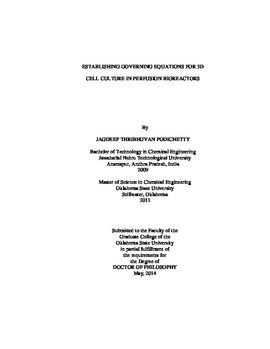| dc.description.abstract | Culturing cells and regenerating tissues in vitro on 3D scaffolds involves several challenges, such as efficient nutrient transportation, uniform stress distribution, and the removal of wastes. Bioreactors not only allow reproducibility but also provide a controlled environment for production of tissues. The objective of this study was to establish fundamental governing equations for the design of tissue engineering bioreactors and scaffolds. The governing equations related to nutrient permeability, mechanical and structural properties of the scaffolds, as well as nutrient consumption kinetics were tested. Large scaffolds with a high aspect ratio were utilized so that the obtained experimental measurements have high signal-to-noise ratio. This allowed the validation of the governing equations used in the computational models with high fidelity. Three different scaffold preparation techniques, freeze drying, salt leaching, and electrospinning were used to fabricate scaffolds with different microarchitecture. Chitosan, gelatin, and polycaprolactone polymers were used to prepare scaffolds. Two types of bioreactor configurations, flow-through and axial-flow, were used in this study. Both were designed to hold same sized scaffolds, but differ in flow configuration, which made them suitable for evaluating and validating the equations. Bioreactors of appropriate flow configuration were constructed in-house for experimental analysis. Computational Fluid Dynamics (CFD) simulations were performed to predict pressure drop, shear stress, deformation, nutrient distribution profile and exit concentration at various operating conditions. Additionally, non-ideal distribution models such as segregation and dispersion were combined with residence time distribution to predict the exit concentration. The model predictions were validated using an experimental setup with metabolically active liver cells. The results show that the scaffold permeability can be calculated using scaffold pore characteristics and deformation could be predicted using simulation. The axial-flow bioreactor performed better than flow-through bioreactor with superior nutrient distribution, lower shear stress, and deformation. Comparison of the outlet oxygen concentrations between the simulation and experimental results showed good agreement with the dispersion model. However, outlet oxygen concentrations from segregation model were lower. These insights help monitor in vitro tissue regeneration, understand the effect of mechanical stimulus on 3D cell culture, and improve quality of the regenerated tissue. | |
